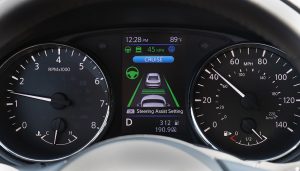
Many obstacles still face a world with full self-driving cars on the road
Auto Alliance: Autonomous Cars Are a Long Way Off
The Auto Alliance, a powerful trade group of automakers, recently filed a statement with the U.S. Senate Committee on Commerce, Science and Transportation. It covers a few innovations in the vehicle market, including the self-driving movement.
Instead of denying that autonomous vehicles will be a reality, the group says they’re a long way off from being reality. It’s talking about full self-driving cars, not vehicles that can do some things for humans like parallel parking.
Right now, we have cars that will control following distance and even stay within well-marked lane lines on highways. But a human still needs to be ready at any moment to take over, just in case. That’s probably going to be the case for some time.
In its statement, the Auto Alliance, or fully the Alliance of Automobile Manufacturers, predicts full autonomous cars won’t even be ready for any consumers until at least 2025.
Adoption Rates
As pointed out by Auto Alliance, it’s going to take time for the technology to be adopted. For one, the new technology will cost a pretty penny. Many Americans can’t afford new vehicles currently. Once you add in all these systems, the cost factor will slow adoption considerably.
When you consider just how many vehicles are on the road today, it will take time for them to turn over. Many modern cars last over 20 years without major repairs. That will slow the self-driving revolution.
“Ubiquity is not projected to occur for at least four decades largely due to the fact that over 260 million light duty vehicles are registered in the U.S.,”Auto Alliance CEO and President Mitch Bainwol said in his address to the committee.
So Many Sensors
Really, human beings are loaded with sensors. We have five senses: sight, hearing, taste, smell and touch. You might not use your sense of taste while driving (unless you’re eating or drinking something), but you do use the rest.
Many autonomous vehicles have cameras, radar, and maybe LIDAR sensors. These address sight issues only. While the car might have more than two of these sensors, outnumbering your number of eyes, they don’t address everything a human can do.
It might sound ridiculous at first, but an autonomous car can’t hear a police or fire emergency siren. This could be a huge security risk when you’re approaching a blind corner at an intersection. Further, a self-driving vehicle can’t smell if something is burning, signaling a fault with the electrical system or fuel lines.
While backup cameras and radar can enhance our abilities, they certainly don’t replace them. Trying to do everything a human can would make autonomous cars even more expensive.
Trouble with Kangaroos
Most of the time when you’re driving, you deal with boring, routine situations. That’s why so many people can zone out while behind the wheel, or even fall asleep. It’s easy to see how a robot could take over for those scenarios. But life’s unpredictable, and that’s where the machines fall short.
Volvo was reminded of this fact. Despite being a safety guru that’s pioneered animal-oriented tests like avoiding sudden moose entries on roadways, Swedish engineers have been stumped by kangaroos. The famous hopping marsupials have been the most challenging animals for self-driving Volvos yet.
Without getting too technical, the onboard sensors use the ground as a reference point. Kangaroos, if you didn’t know, jump unpredictably. Not only that, as the animal is up in the air, it looks further away than it is. As it lands, the vehicle has trouble adjusting to it looking suddenly much closer.
Of course, Australians know how dangerous kangaroo collisions can be. About 80 percent of animal collisions in the land Down Under involve these creatures, so they’re a real threat.
Google’s self-driving car project has run into problems with squirrels darting into the road. Sometimes birds will land in your path to grab food. Plenty of other creatures can scamper about, and many move quickly as well as erratically. These present challenges for human drivers, to be sure, but autonomous cars struggle even more.
Four Decades Out
Auto Alliance predicts self-driving cars won’t become popular for about four decades. That’s a long time coming. And that doesn’t mean all vehicles will drive for humans.
There will always be a section of the population that likes driving without robot assistance, and for now it looks like that will always be accommodated.





